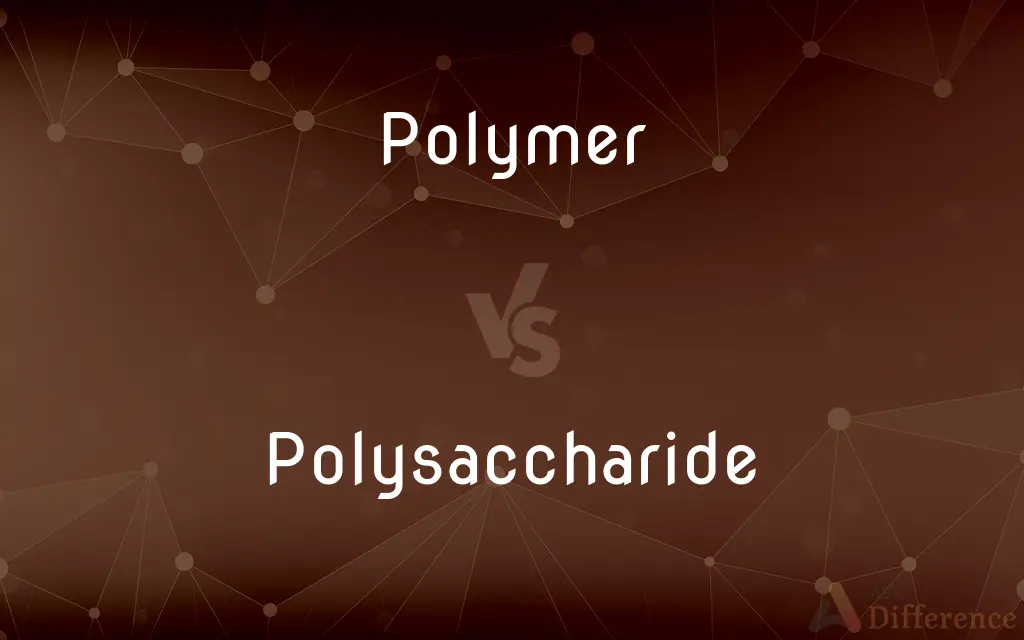Polymer vs. Polysaccharide — What's the Difference?
Edited by Tayyaba Rehman — By Maham Liaqat — Updated on March 10, 2024
A polymer is a large molecule composed of repeating units, while polysaccharides are specific polymers made of sugar units.

Difference Between Polymer and Polysaccharide
Table of Contents
ADVERTISEMENT
Key Differences
Polymers are broad class of natural or synthetic materials made up of long chains of repeating molecular units (monomers), which can include a variety of substances from plastics to proteins. Polysaccharides, on the other hand, are a specific type of polymer composed exclusively of sugar monomers linked together. They play key roles in biological processes and structures.
While polymers can be found across a wide range of applications, including industry, medicine, and everyday products, polysaccharides are specifically significant in biological contexts, such as energy storage (starch in plants, glycogen in animals) and structural components (cellulose in plants, chitin in fungal cell walls and insect exoskeletons).
The diversity of polymers is vast, encompassing materials with different properties and uses, from flexible and lightweight plastics to durable and resistant fibers. Polysaccharides, while also diverse within their own category, are primarily focused on biological functionality, offering energy storage solutions, structural support, and playing roles in cell recognition and signaling.
Polymers are synthesized through various chemical reactions, often requiring catalysts and specific conditions for polymerization, which can result in a wide range of material properties. Polysaccharides are synthesized biologically through enzymatic processes, resulting in precise and functional structures necessary for living organisms.
The study and application of polymers span material science, engineering, and technology, aiming to develop new materials with tailored properties. The study of polysaccharides, while also interdisciplinary, is deeply integrated into biochemistry, plant science, and nutrition, focusing on understanding biological processes and the development of applications like dietary fibers and biofuels.
ADVERTISEMENT
Comparison Chart
Definition
Large molecules formed by repeating monomers
Specific type of polymer made of sugar units
Composition
Can be composed of various monomers
Composed exclusively of sugar monomers
Applications
Broad, including plastics, fibers, films
Primarily biological, like energy storage and structural components
Diversity
Includes plastics, proteins, nucleic acids, etc.
Includes starch, cellulose, glycogen, chitin
Synthesis
Chemical reactions, often in industrial settings
Biological processes, enzymatically catalyzed
Key Functions
Structural, functional, or decorative in various industries
Energy storage, structural support in living organisms
Fields of Study
Material science, engineering
Biochemistry, plant science, nutrition
Compare with Definitions
Polymer
Can be engineered for specific uses.
Polycarbonate polymers are used in bulletproof glass.
Polysaccharide
Found in foods as starches and fibers.
Starch is a polysaccharide that stores energy in plants.
Polymer
Diverse in structure and function.
Proteins are polymers that play critical roles in biological processes.
Polysaccharide
Carbohydrate polymer made of sugar molecules.
Cellulose is a polysaccharide that gives plants structural support.
Polymer
Studied in material science.
Researchers are developing biodegradable polymers to reduce plastic waste.
Polysaccharide
Plays a role in biological recognition and signaling.
Heparin is a polysaccharide that helps in blood coagulation.
Polymer
Large molecule made from many smaller units (monomers).
Nylon, a synthetic polymer, is widely used in textiles.
Polysaccharide
Can be used to produce biofuels.
Cellulosic ethanol is made from the polysaccharide cellulose.
Polymer
Basis of many materials including plastics and natural substances.
DNA is a natural polymer essential for genetic information.
Polysaccharide
Essential in diet for digestive health.
Dietary fiber, a type of polysaccharide, is important for maintaining a healthy gut.
Polymer
A polymer (; Greek poly-, "many" + -mer, "part") is a substance or material consisting of very large molecules, or macromolecules, composed of many repeating subunits. Due to their broad spectrum of properties, both synthetic and natural polymers play essential and ubiquitous roles in everyday life.
Polysaccharide
Polysaccharides (), or polycarbohydrates, are the most abundant carbohydrate found in food. They are long chain polymeric carbohydrates composed of monosaccharide units bound together by glycosidic linkages.
Polymer
Any of numerous natural and synthetic compounds of usually high molecular weight consisting of up to millions of repeated linked units, each a relatively light and simple molecule.
Polysaccharide
A carbohydrate (e.g. starch, cellulose, or glycogen) whose molecules consist of a number of sugar molecules bonded together.
Polymer
(organic chemistry) A long or larger molecule consisting of a chain or network of many repeating units, formed by chemically bonding together many identical or similar small molecules called monomers. A polymer is formed by polymerization, the joining of many monomer molecules.
Polysaccharide
Any of a class of carbohydrates, such as starch and cellulose, consisting of a number of monosaccharides joined by glycosidic bonds.
Polymer
A material consisting of such polymer molecules.
Polysaccharide
(carbohydrate) A polymer made of many saccharide units linked by glycosidic bonds.
Cellulose, starches, and complex carbohydrates, such as glycogen, are common polysaccharides in biology.
Polymer
Any one of two or more substances related to each other by polymerism; specifically, a substance produced from another substance by chemical polymerization.
Polysaccharide
Any of a class of carbohydrates whose molecules contain chains of monosaccharide molecules
Polymer
A naturally occurring or synthetic compound consisting of large molecules made up of a linked series of repeated simple monomers
Common Curiosities
What are common examples of polymers?
Common examples include polyethylene (plastic bags), polystyrene (Styrofoam), and natural proteins (like keratin in hair).
How do polymers differ from polysaccharides?
While all polysaccharides are polymers, not all polymers are polysaccharides. Polymers can be made from various monomers, while polysaccharides are specifically made from sugars.
What are polymers?
Polymers are large molecules composed of repeating monomer units, found in various forms including plastics, proteins, and DNA.
Can polymers be biodegradable?
Yes, some polymers, especially those derived from biological materials, are designed to be biodegradable.
What are common examples of polysaccharides?
Common examples include cellulose (in plant cell walls), starch (in potatoes and grains), and glycogen (energy storage in animals).
What role do polysaccharides play in the body?
Polysaccharides serve as energy reserves (starch and glycogen) and as structural components (cellulose and chitin).
What are polysaccharides?
Polysaccharides are carbohydrates made of long chains of sugar molecules, involved in energy storage and providing structural support in organisms.
How is the structure of polymers determined?
The structure of polymers is determined by the types of monomers they contain and how these monomers are linked together.
Are all polysaccharides digestible by humans?
No, some polysaccharides like cellulose are not digestible by humans and serve as dietary fiber, aiding in digestion.
What environmental concerns are associated with polymers?
Non-biodegradable polymers, particularly plastics, pose significant environmental challenges due to their persistence in ecosystems and contribution to pollution.
How are polysaccharides related to nutrition?
Polysaccharides like dietary fibers are important for digestive health, while others like starch are key sources of energy.
What scientific fields are involved in polymer research?
Polymer research spans chemistry, physics, materials science, and engineering, among others.
How are polymers used in everyday life?
Polymers are used in a wide range of products, from packaging materials and clothing to medical devices and household goods.
Can polysaccharides be synthesized in the lab?
Yes, certain polysaccharides can be synthesized or modified in the lab for specific applications, including medical uses.
What is the significance of synthetic polymers?
Synthetic polymers, such as plastics and synthetic fibers, have revolutionized industries with their versatility and durability.
Share Your Discovery

Previous Comparison
Uterus vs. Womb
Next Comparison
Tablet vs. PillAuthor Spotlight
Written by
Maham LiaqatEdited by
Tayyaba RehmanTayyaba Rehman is a distinguished writer, currently serving as a primary contributor to askdifference.com. As a researcher in semantics and etymology, Tayyaba's passion for the complexity of languages and their distinctions has found a perfect home on the platform. Tayyaba delves into the intricacies of language, distinguishing between commonly confused words and phrases, thereby providing clarity for readers worldwide.














































